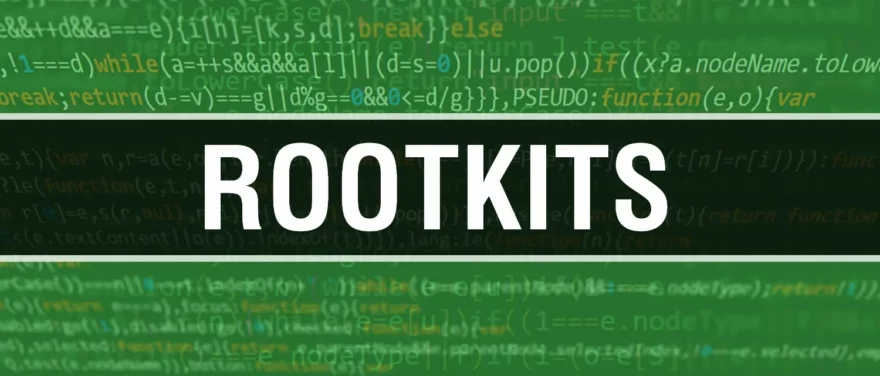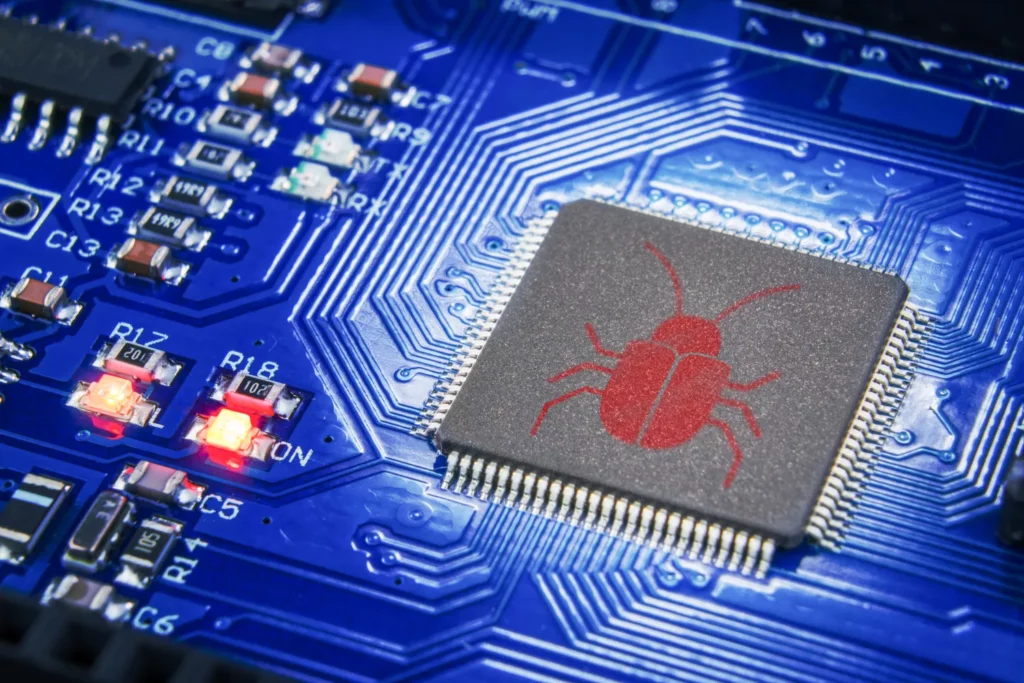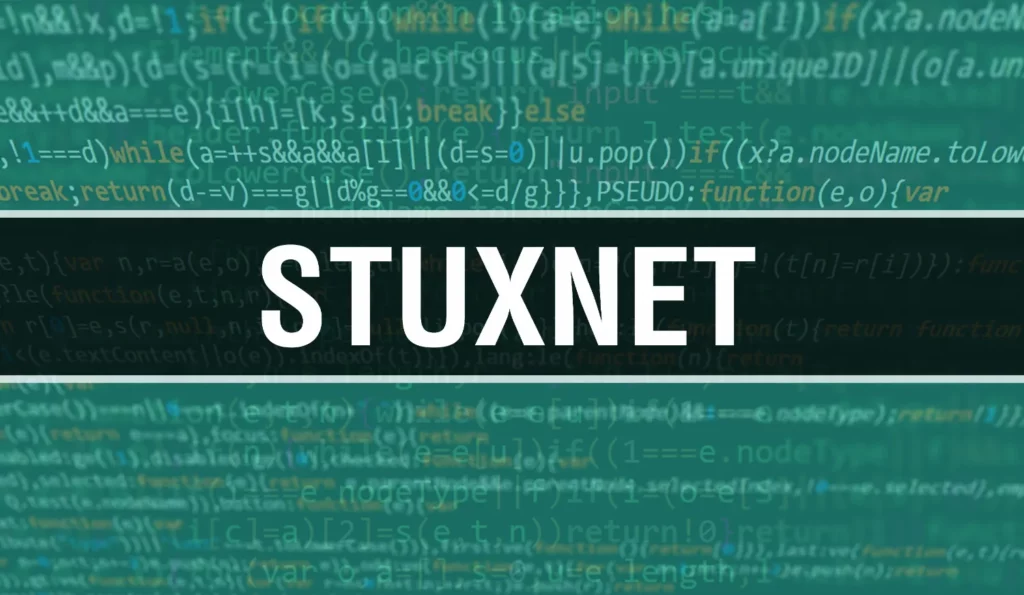
Rootkits are a sneaky kind of harmful software that’s often linked to malware such as worms, viruses, and trojans. They’re like secret doorways that let hackers and unauthorised individuals sneak into your computer system and take control. This unwanted access is often undetected by classic security systems. Understanding rootkits is crucial in today’s digital landscape, where cyber threats continue to evolve and become more sophisticated.
What are Rootkits?
Rootkits are stealthy software programmes designed to conceal their presence and provide unauthorised access to a computer system. They are often difficult to detect and tricky to remove because they operate at a deep level within the operating system. It can modify system files, alter system behaviour, and manipulate security mechanisms, granting attackers control over the compromised system.
Understanding Rootkits is vital for both individuals and organisations. Users can better protect their systems against potential attacks by comprehending their capabilities and techniques. They pose significant risks, such as data theft, unauthorised system control, and the ability to serve as a launching point for further cyber-attacks.
Understanding Rootkits
Rootkits are sophisticated malware tools that enable unauthorised individuals or attackers to gain privileged access and control over a computer system while remaining hidden from detection. They are designed to conceal their presence and manipulate the operating system to achieve their objectives. Rootkits operate at a deep level within the system, often compromising the kernel or other critical components. By modifying system files, processes, and system calls, they can bypass security mechanisms and grant attackers complete control over the compromised system. It can also be used for various malicious purposes, such as stealing sensitive data, enabling remote control, launching further attacks, or hiding other malicious activities.

Historical Background and Evolution of Rootkits
Rootkits first appeared in the early 1980s when computer security researchers developed tools to gain root-level access to Unix systems. These early versions focused on maintaining access to systems rather than remaining undetected. As computer systems and security measures evolved, they adapted and became more sophisticated. When personal computers and internet access spread in the 1990s, rootkits started to gain prominence as a favoured tool for attackers.
Over the years, rootkits have evolved in complexity and stealthiness. They have taken advantage of advances in technology and software vulnerabilities to enhance their capabilities. The rise of rootkit toolkits, such as the infamous Hacker Defender and Fu rootkit, made it easier for attackers to develop and deploy rootkits with minimal effort. The emergence of virtualisation technology and the increasing prevalence of firmware-based systems have opened up new avenues for rootkit development and exploitation.
Common Objectives and Motivations Behind Rootkit Development
Rootkits are developed with specific objectives in mind, driven by various motivations. Some common objectives and motivations include:
- Privileged access: Aims to provide unauthorised users with elevated privileges, gaining complete control over a system and its resources.
- Persistence: Strive to maintain their presence on a compromised system for as long as possible, even after system reboots or security measures are implemented.
- Stealth and evasion: Focus on remaining undetected by the security software, monitoring tools, and system administrators. They employ various techniques, such as hiding their presence in system files or manipulating system behaviour, to avoid detection.
- Information theft: Target sensitive information, including passwords, financial data, intellectual property, or personal information, to gain access and possibly leak this information.
- Remote control: Some enable remote access to the compromised system, allowing attackers to execute commands, install additional malware, or use the system as a launching pad for other attacks.
- Botnet recruitment: Hackers may use Rootkits to recruit compromised systems into a botnet. That creates a network of controlled machines that can be used for distributed denial-of-service (DDoS) attacks, spam campaigns, or other malicious activities.
Understanding the objectives and motivations behind rootkit development is essential in devising effective strategies to detect, prevent, and mitigate their impact. It helps security professionals and system administrators stay ahead of evolving rootkit techniques and develop appropriate defence mechanisms.
Types of Rootkits
There are 3 types of toolkits that we will discuss by definition and examples.

User-Mode Rootkits
User-mode rootkits operate at the user level within an operating system, manipulating system behaviour and intercepting system calls. They are relatively easier to develop and do not require administrative privileges.
Examples of User-Mode Rootkits:
- Adware-based rootkits: Accompany adware or potentially unwanted programmes (PUPs) to deliver targeted advertisements while evading detection.
- Keyloggers: Capture keystrokes to compromise sensitive information.
- Browser-based rootkits: Exploit vulnerabilities in web browsers to modify behaviour or redirect users to malicious websites.
Techniques used by User-Mode Rootkits:
- API hooking: Intercept and modify application programming interfaces (APIs).
- Code injection: Inject malicious code into legitimate processes.
- DLL injection: Inject malicious dynamic link libraries (DLLs) into processes.
- Process hiding: Manipulate process lists or modify system data structures to hide their presence.
Kernel-Mode Rootkits
Kernel-mode rootkits operate at the kernel level, targeting core components of the operating system. They require administrative privileges and are more difficult to detect and remove.
Examples of Kernel-Mode Rootkits:
- Alureon/TDL rootkit: Modifies the Windows kernel, intercepts network traffic, and manipulates search engine results.
- Rustock rootkit: Hides spam email distribution networks by manipulating the network stack.
- ZeroAccess/Sirefef rootkit: Uses advanced techniques to hide its presence associated with click fraud and Bitcoin mining activities.
Techniques used by Kernel-Mode Rootkits:
- Direct Kernel Object Manipulation (DKOM): Manipulates data structures within the kernel.
- Kernel hooking: Modifies function pointers and interrupt handlers to control system behaviour.
- Kernel driver modification: Modifies or installs malicious kernel drivers for privileged access.
- Stealth techniques: Employ advanced techniques like memory manipulation or process hollowing to evade detection.
Hardware/Firmware Rootkits
Hardware/firmware rootkits target system firmware or hardware components, providing persistent and covert control over the compromised system.
Examples of Hardware/Firmware Rootkits:
- LoJax: Targets UEFI and infects motherboard firmware, controlling the system even after OS reinstallation.
- BadUSB: Exploits USB vulnerabilities to modify the firmware in USB devices for malicious actions.
Techniques used by Hardware/Firmware Rootkits:
- Firmware modification: Modifies system firmware to gain control and persistence.
- Device driver modification: Modifies firmware or device drivers of peripherals for control.
- Device firmware emulation: Emulates legitimate device firmware while hiding malicious actions.

Detecting and Preventing Rootkits
Now that you know what Rootkits are, you might be wondering how to protect your devices and online safety.
Anti-Rootkit Tools
Popular Anti-Rootkit Software such as Malwarebytes Anti-Rootkit, GMER, and Rootkit Remover is considered very effective in detecting and removing Rootkits. These tools specialise in detecting and removing rootkits from infected systems.
Features and Capabilities of Effective Anti-Rootkit Tools: Effective anti-rootkit tools possess features like deep scanning capabilities, the ability to detect hidden processes and files, and rootkit-specific detection algorithms. They also provide real-time protection, automatic updates, and quarantine or removal options for detected rootkits.
System Hardening
Regular System Updates: Regularly updating the operating system, applications, and security patches is crucial to protect against known vulnerabilities that rootkits may exploit. Patching vulnerabilities minimises the risk of rootkit infections.
Implementing Secure Boot Mechanisms: The Unified Extensible Firmware Interface (UEFI) Secure Boot feature is a secure boot mechanism that verifies the integrity and authenticity of the boot process. This prevents unauthorised modifications to the boot sequence and protects against rootkits that attempt to manipulate the system during startup.
Enforcing Strong Access Controls and Permissions: By implementing strong access controls and permissions, such as user account separation and the principle of least privilege, the potential for rootkit installation and malicious activities can be significantly reduced. Restricting administrative privileges limits the ability of rootkits to gain control over critical system components.
Secure Boot and Trusted Platform Module (TPM)
Secure Boot and TPM: Secure Boot is a feature that ensures the system only boots with trusted and digitally signed bootloaders and operating system components. Trusted Platform Module (TPM) is a hardware component that provides cryptographic services, enhancing system security.
Utilising Secure Boot and TPM to Prevent Rootkit Infections: Enabling Secure Boot and utilising TPM can prevent rootkits from tampering with the boot process and ensure the integrity of system components. Secure Boot verifies the authenticity of each boot component, while TPM can store cryptographic keys and measurements to ensure system integrity.
Behaviour-Based Detection Techniques
Implementing Behaviour Monitoring Tools: Behaviour monitoring tools analyse system activities and detect abnormal behaviour that could indicate the presence of a rootkit. These tools monitor processes, file system modifications, network connections, and registry changes.
Detecting Suspicious Activities and Rootkit Behaviours: Behaviour-based detection techniques can identify rootkit-related activities, such as hooking system functions, injecting code into processes, or modifying critical system files. By analysing behaviour patterns, these techniques can raise alerts or take preventive actions.
Network Security Measures
Firewalls and Intrusion Detection Systems (IDS): Firewalls and IDS can detect and prevent rootkits from infiltrating a network successfully. Firewalls filter network traffic, while IDS monitors network activity for signs of intrusion, including rootkit-related behaviours.
Network Segmentation and Isolation to Minimise Attack Surface: Segmenting networks and isolating critical systems or sensitive data reduces the attack surface for rootkits. By limiting network connectivity and implementing strict access controls, the spread and impact of rootkits can be minimised.

User Education and Best Practices
Educating users about the risks associated with rootkits and the importance of practising good cybersecurity hygiene is crucial.
Encouraging Safe Browsing Habits and Avoiding Suspicious Downloads
Users should avoid suspicious websites, avoid any unknown links or pop-ups, and refrain from downloading files from untrusted sources. These practices reduce the likelihood of inadvertently downloading rootkit-infected files.
By combining anti-rootkit tools, hardening system measures, behaviour-based detection techniques, network security measures, and user education, organisations and individuals can significantly enhance their ability to detect and prevent rootkit infections. These proactive measures help maintain the integrity and security of computer systems.
Case Studies and Real-World Examples
Notable Rootkit Incidents and Their Impact Rootkit attacks have had significant impacts on individuals, organisations, and even entire industries. Here are a few notable examples:
Sony BMG’s CD Rootkit
In 2005, Sony BMG distributed music CDs containing a rootkit as a part of their Digital Rights Management (DRM) software. The rootkit, designed to prevent unauthorised copying, compromised the security of users’ computers and opened them up to potential exploitation by other malicious actors. This incident sparked widespread outrage and legal action against Sony BMG.
Stuxnet
Stuxnet, discovered in 2010, was a highly sophisticated and targeted malware that was specifically aimed at Iran’s nuclear facilities. It employed multiple rootkit techniques to remain undetected and manipulated industrial control systems to disrupt Iran’s uranium enrichment efforts. Stuxnet demonstrated the potential of rootkits as a tool for cyber warfare and highlighted the need for robust defences in critical infrastructure systems.

Duqu
Duqu, discovered in 2011, was sophisticated spyware believed to be related to Stuxnet. It utilised rootkit techniques to evade detection and gather sensitive information from targeted organisations, particularly those involved in advanced research and development. Duqu highlighted the persistent threat posed by rootkits for espionage purposes.
By analysing and learning from past rootkit incidents, organisations and individuals can better understand the evolving threat landscape and strengthen their defences against rootkit attacks. It is essential to remain vigilant, implement robust security measures, and stay informed about emerging rootkit trends to mitigate the potential risks associated with these stealthy and damaging threats.
Rootkits continue to evolve and become more sophisticated, making them challenging to detect and remove. As technology advances, new rootkit variants may emerge, targeting novel attack vectors. Therefore, staying updated with the latest security practices, research, and technologies is crucial. Collaboration between security professionals, researchers, and industry stakeholders is vital to developing effective countermeasures against rootkit attacks.
While rootkits present a formidable challenge, advancements in machine learning, artificial intelligence, and behavioural analytics offer promising avenues for improving rootkit detection and prevention. Additionally, ongoing user education and awareness play a critical role in mitigating the risk of rootkit infections.
